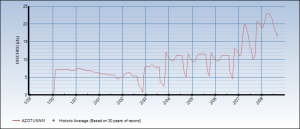Today’s high in Durango was 59F (15C), 18 degrees above the 1981-2010 average for Feb. 8. In the mountains to the east – the mountains that provide Albuquerque’s San Juan-Chama drinking water – the snow has already begun to melt.
The snowpack there is lousy to begin with – 62 percent of normal for this time of year at the sites measured with automated SNOTEL gauges. But the first week of February is ridiculously early for the Azotea Tunnel, which brings SJC water under the continental divide and drops it into the Rio Grande Basin, to begin flowing.
 It’s not a lot of water right now, a peak of ~23 cubic feet per second this morning. But the normal for this time of year is zero, and the tunnel typically doesn’t break 20cfs until the second week in March. This is basically a month early. I went back to U.S. Bureau of Reclamation data on this, and found that only five times during the last 30 years has there been any flow at all in February.
It’s not a lot of water right now, a peak of ~23 cubic feet per second this morning. But the normal for this time of year is zero, and the tunnel typically doesn’t break 20cfs until the second week in March. This is basically a month early. I went back to U.S. Bureau of Reclamation data on this, and found that only five times during the last 30 years has there been any flow at all in February.
The worry here is not early melt. We’ve had that pattern for a while, with more of the snowmelt coming in March-May, and less in June and July. The early melt water coming through the tunnel will end up in Heron Reservoir, part of usable supply for Albuquerque and the other SJC water users. The worry is that weather this warm, dry and early could start a round of early sublimation – snow evaporating into the dry air before it has a chance to melt . This has been a repeated problem in recent years, with warm dry springs eating into the snowpack, turning lousy years (with too little snow) into even worse years (with even less runoff that you’d expect given how much snow we have gotten).

The early melt is only part of the problem, as this stretch of unusually warm weather comes during a time when new snowfall would normally be adding to the snowpack SWE, especially in the headwaters of the Rio Chama. See the link to NRCS Cumbres Trestle SNOTEL graph below.
http://www.wcc.nrcs.usda.gov/nwcc/view?intervalType=View+Current+&report=WYGRAPH×eries=Daily&format=plot&interval=WATERYEAR&sitenum=431&wateryear=
Ed – So you’re referring to the little down blip on the Cumbres graph – subtracting rather than adding?
Sublimation has been my worry every time I look across the Rio Grande Rift to the Sangre de Cristo Mountains. It seems that the snow is just “corroding” away in the dry, warm air. Thus, not only is it disappearing, but not even making it downslope. Is sublimation as much of a problem in the Sangres as I think it is?
Not the current tiny blip down on the observed SWE, but look what the median 1981-2000 SWE (pale purple line) does during the month of February…it’s the up-up-and away that we are missing out on by otherwise enjoying the lack of winter storms. it’s all about the opportunity lost by not adding to the snowpack/SWE.